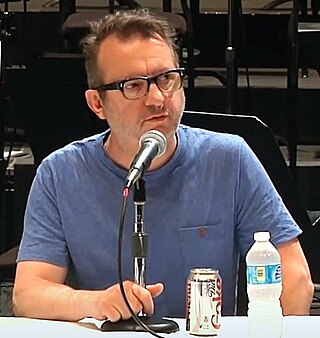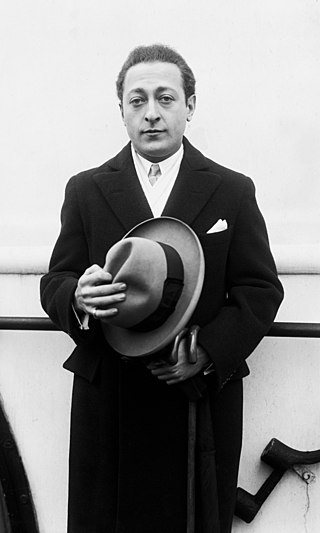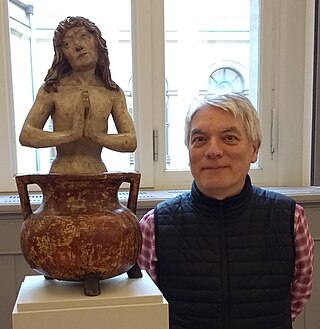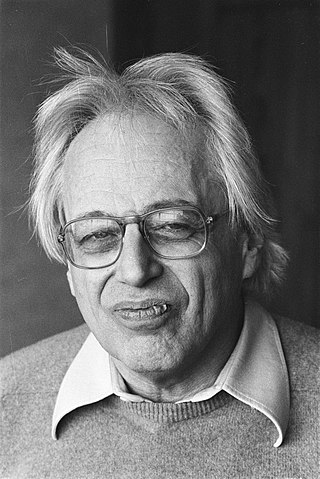Related Research Articles

In music, a cadenza is, generically, an improvised or written-out ornamental passage played or sung by a soloist or soloists, usually in a "free" rhythmic style, and often allowing virtuosic display. During this time the accompaniment will rest, or sustain a note or chord. Thus an improvised cadenza is indicated in written notation by a fermata in all parts. A cadenza will usually occur over either the final or penultimate note in a piece, the lead-in, or the final or penultimate note in an important subsection of a piece. It can also be found before a final coda or ritornello.

Mark-Anthony Turnage CBE is a British composer of classical music.

The Violin Concerto in D major, Op. 61, was written by Ludwig van Beethoven in 1806. Its first performance by Franz Clement was unsuccessful and for some decades the work languished in obscurity, until revived in 1844 by the then 12-year-old violinist Joseph Joachim with the orchestra of the London Philharmonic Society conducted by Felix Mendelssohn. Joachim would later claim it to be the "greatest" German violin concerto. Since then it has become one of the best-known and regularly performed violin concertos.

The Violin Concerto in D minor, Op. 47 of Jean Sibelius, originally composed in 1904 and revised in 1905, is the only concerto by Sibelius. It is symphonic in scope and included an extended cadenza for the soloist which takes on the role of the development section in the first movement.

Felix Mendelssohn's Violin Concerto in E minor, Op. 64, is his last concerto. Well received at its premiere, it has remained among the most prominent and highly-regarded violin concertos. It holds a central place in the violin repertoire and has developed a reputation as an essential concerto for all aspiring concert violinists to master, and usually one of the first Romantic era concertos they learn. A typical performance lasts just under half an hour.

The Violin Concerto by William Walton was written in 1938–39 and dedicated to Jascha Heifetz, who commissioned the work and performed it at its premiere on 7 December 1939 with the Cleveland Orchestra conducted by Artur Rodziński. The British premiere, delayed by the Second World War, was given on 1 November 1941, with Henry Holst as soloist and the composer conducting. Walton later reorchestrated the concerto; the revised version was premiered in 1944. The work has been frequently recorded and has established itself as one of the composer's most durable compositions.

Augusta Read Thomas is an American composer and professor.

Simon Holt is an English composer.

The Concerto for Violin and Orchestra by György Ligeti is a violin concerto written for and dedicated to the violinist Saschko Gawriloff. A performance of the work lasts about 28 minutes.
Philip Glass's Violin Concerto No. 1 was commissioned by the American Composers Orchestra for soloist Paul Zukofsky and premiered in New York City on 5 April 1987. The work was composed with Glass's late father in mind. The piece quickly became one of Glass's most popular works. It is usually around 25–30 minutes in duration when performed.

Andreas Makris was a Greek-American composer and violinist, born in Kilkis, Greece, on March 7, 1930. He was a Composer-in-Residence for many years at the National Symphony Orchestra in Washington DC, working with conductors such as Howard Mitchell, Mstislav Rostropovich, Antal Dorati, and Leonard Slatkin. He composed around 100 works for orchestra, chamber ensembles, and solo instruments, including the Aegean Festival Overture, which, transcribed for concert band by Major Albert Bader of the USAF Band, became a popular piece with US bands. Grants and awards he received include the Damroch Grant, National Endowment for the Arts Grant, the Martha Baird Rockefeller Award, ASCAP Award, the Fulbright Scholarship, and citations from the Greek Government.
Anna Clyne is an English composer, now resident in New York City, US. She has worked in both acoustic music and electro-acoustic music.
The Concerto Fantasy for Two Timpanists and Orchestra is a double timpani concerto written by Philip Glass in 2000. It is paired with the Cello Concerto on Vol. I of Glass' Concerto Project, a set of eight concerti by the composer. A typical performance of the work lasts 25–28 minutes. It was written for Jonathan Haas and later recorded by Evelyn Glennie, and was premiered by Haas and Svet Stoyanov with the American Symphony Orchestra in Avery Fisher Hall, Lincoln Center, conducted by Leon Botstein. The work was commissioned jointly by the American Symphony Orchestra, the Peabody Symphony, the Milwaukee Symphony, the St. Louis Symphony and the Phoenix Symphony. In 2004, a transcription for wind ensemble was written by Mark Lortz, which debuted at Peabody Institute in 2005.
The Concerto Grosso No. 1 was the first of six concerti grossi by Soviet composer Alfred Schnittke. It was written in 1976–1977 at the request of Gidon Kremer and Tatiana Grindenko who were also the violin soloists at its premiere on 21 March 1977 in Leningrad together with Yuri Smirnov on keyboard instruments and the Leningrad Chamber Orchestra under Eri Klas. It is one of the best-known of Schnittke's polystylistic compositions and marked his break-through in the West.
The Seamstress is a concerto for solo violin and orchestra by the British-born composer Anna Clyne. The work was commissioned by the Chicago Symphony Orchestra, for which Clyne was then composer-in-residence. It was first performed May 28, 2015 at Symphony Center, Chicago by the violinist Jennifer Koh and the Chicago Symphony Orchestra under conductor Ludovic Morlot. The Seamstress marks the second collaboration between Clyne and Koh, who had previously premiered Clyne's double violin concerto Prince of Clouds in November 2012.
The Violin Concerto No. 3, Juggler in Paradise is a composition for violin solo and orchestra by the American composer Augusta Read Thomas. The work was jointly commissioned by Radio France, The Proms, and the National Symphony Orchestra with contributions from Bill and Solange Brown. It was first performed on January 16, 2009 at the Salle Pleyel, Paris by the violinist Frank Peter Zimmermann and the Orchestre philharmonique de Radio France under the conductor Andrey Boreyko.
The Violin Concerto No. 2 is a composition for violin solo and orchestra by the Finnish composer Magnus Lindberg. The work was jointly commissioned by the London Philharmonic Orchestra, the Berlin Philharmonic, Swedish Radio Symphony Orchestra, Radio France, and New York Philharmonic. Its world premiere was given by the violinist Frank Peter Zimmermann and the London Philharmonic Orchestra under the direction of Jaap van Zweden at Royal Festival Hall, London, on December 9, 2015. The piece is dedicated to Zimmermann.

The Concerto no. 4 for Violin and Orchestra is a violin concerto by Soviet and German composer Alfred Schnittke. It was commissioned by the 34th Berlin Festival and written in 1984. Its first performance was given in Berlin on 11 September 1984 with dedicatee Gidon Kremer as soloist and the Berlin Philharmonic Orchestra conducted by Christoph von Dohnányi.
References
- 1 2 3 Mazzoli, Missy (2021). "Violin Concerto (Procession)". G. Schirmer Inc. Retrieved July 2, 2023.
- ↑ Brodeur, Michael Andor (February 4, 2022). "Gemma New brings out a softer side of the NSO". The Washington Post . Retrieved July 2, 2023.
- ↑ Macaulay, Alastair (August 17, 2022). "BBC Proms review — Missy Mazzoli's spells make the orchestra dance". Financial Times . Retrieved July 2, 2023.
- ↑ Clements, Andrew (August 16, 2022). "Prom 38: Philharmonia/Santtu-Matias Rouvali review – raucous but undemanding". The Guardian . Retrieved July 2, 2023.